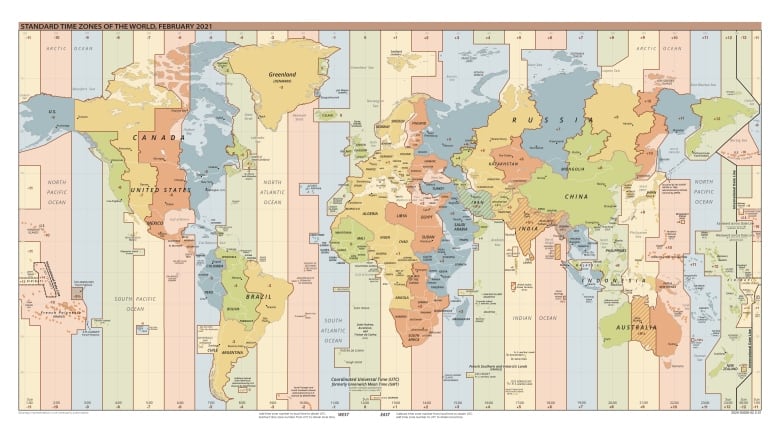
“Tune in tonight at 6 p.m., 6:30 in Newfoundland.”
It’s a familiar refrain to Canadians, a concession to the peculiar 30-minute time zone at the edge of the continent.
The province should by all rights be on Atlantic Time, since most of it falls between the 55th and 65th meridians west, and it might have been had its capital city not also been its most easterly point.
Before time zones, communities followed solar time: when the sun was directly overhead, it was high noon. Even after the invention of mechanical clocks, people set their watches by the sun. As a result, the time in neighbouring towns could differ by small increments, and there were as many as 144 micro time zones across North America.
The discrepancies didn’t matter much in an age of small-scale, slow-speed travel, but the introduction of trains created a sudden need for time standardization. Converting between the various local times caused confusion for passengers and headaches for train companies.
It sometimes even led to disaster. On Aug. 12, 1853, a train bound for Providence in Rhode Island crashed head-on into a train travelling to Worcester, Mass., killing 14 people.

The trains were running on a shared track, and the conductor of the Providence-bound train thought he had pulled off the track long enough for the Worcester train to pass him, not knowing his watch was set to a slower time than the other conductor’s. The two engines collided coming around a blind turn.
British railway companies had been running on the astronomical time measured at Greenwich observatory in London since 1848, but the situation in North America was complicated by the size of the continent: It was far too wide to adopt a single, standard time from coast to coast.
Scottish-Canadian railway engineer Sandford Fleming proposed a solution: divide the globe into 24 time zones, each 15 degrees of longitude wide and one hour apart, with Greenwich mean time (GMT) serving as the international zero hour.
In 1883, North American railroad companies followed Fleming’s proposal and adopted five time zones — Pacific, mountain, central, eastern and intercolonial time (now known as Atlantic time) — and delegates at the International Meridian Conference the following year recommended that Fleming’s plan be implemented worldwide.
While many cities and states voluntarily passed ordinances ratifying this system of “Standard Railway Time,” there were holdouts. Saint John continued to follow local solar time, 24 minutes and 16 seconds behind Atlantic time. In the United States, Detroit and Savannah, Ga., also stuck to local time.
Newfoundland, then a British dominion with an independent government, hadn’t sent a representative to the International Meridian Conference and was disconnected from the railways of continental North America, with only a small railroad on the Avalon Peninsula at the eastern end of the island.

Still, in this new era of telecommunications and high-speed travel, it was increasingly practical for towns within the same political jurisdiction to keep a common time. According to an 1870 budget debate in the House of Assembly, some outports were already setting their clocks by the firing of the noonday gun on Signal Hill in St. John’s. Nearby communities like Carbonear, Trepassey and Placentia were presumably alerted to the timing of the shot by telegraph.
By the end of the 19th century, St. John’s time was used for official purposes across the island. And if you think a half-hour time zone is eccentric, St. John’s time in 1899 was three hours, 30 minutes and 49.5 seconds behind GMT.
Like Saint John, Detroit and Savannah though, some Newfoundland communities rejected standardization.
Heart’s Content, site of the transatlantic telegraph cable linking Newfoundland to Europe, timestamped all of its communications using the local time — three hours, 33 minutes, and 33 seconds behind GMT.
A St. John’s Daily Star article written in 1917 accused the inhabitants of Cape Ray, on Newfoundland’s west coast, of playing particularly fast and loose with time.
“Besides the vagaries of the different clocks which are quite familiar even to people in town where the mid-day gun announces the hour dicernally,” the author wrote, “the people of Cape Ray have such a mixture of ‘times,’ that the compilation of a comparative time table would prove welcome, especially to the stranger.”

Some residents went by St. John’s standard time, the postmaster went by local solar time (26 minutes behind), the lighthouse keeper went by daylight time (one hour ahead), and the wireless officials went by eastern time (one hour 30 minutes behind) to align with their head office in Montreal.
It wasn’t until 1935 that Newfoundland’s Commission of Government passed the Standard Time Act, setting standard time across the dominion to 3.5 hours behind GMT, as close as possible to St. John’s solar time. In the 1930s, dozens of countries were still operating on variations of local solar time. It took the better part of a century for most of the world to come on board with co-ordinated hour-long time zones based on GMT.
Uruguay and Suriname, for example, once shared Newfoundland’s time zone. Then Uruguay dropped a half-hour back in 1942, and Suriname jumped a half-hour ahead in 1984. Today, Newfoundland time is one of just 11 zones left in the world that are offset from co-ordinated universal time (the successor to GMT) by less than a full hour.
Don’t expect a change any time soon, though. Public outcry quashed two attempts to move the province to Atlantic time in 1951 and 1963, and we’ve grown accustomed to our nightly call-out on national television.
Download our free CBC News app to sign up for push alerts for CBC Newfoundland and Labrador. Click here to visit our landing page.


